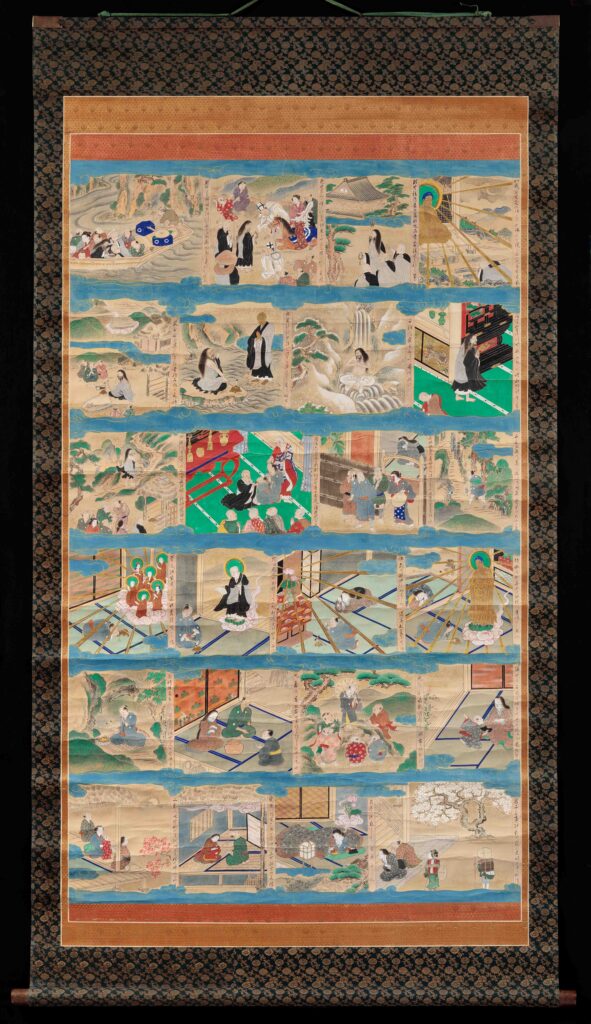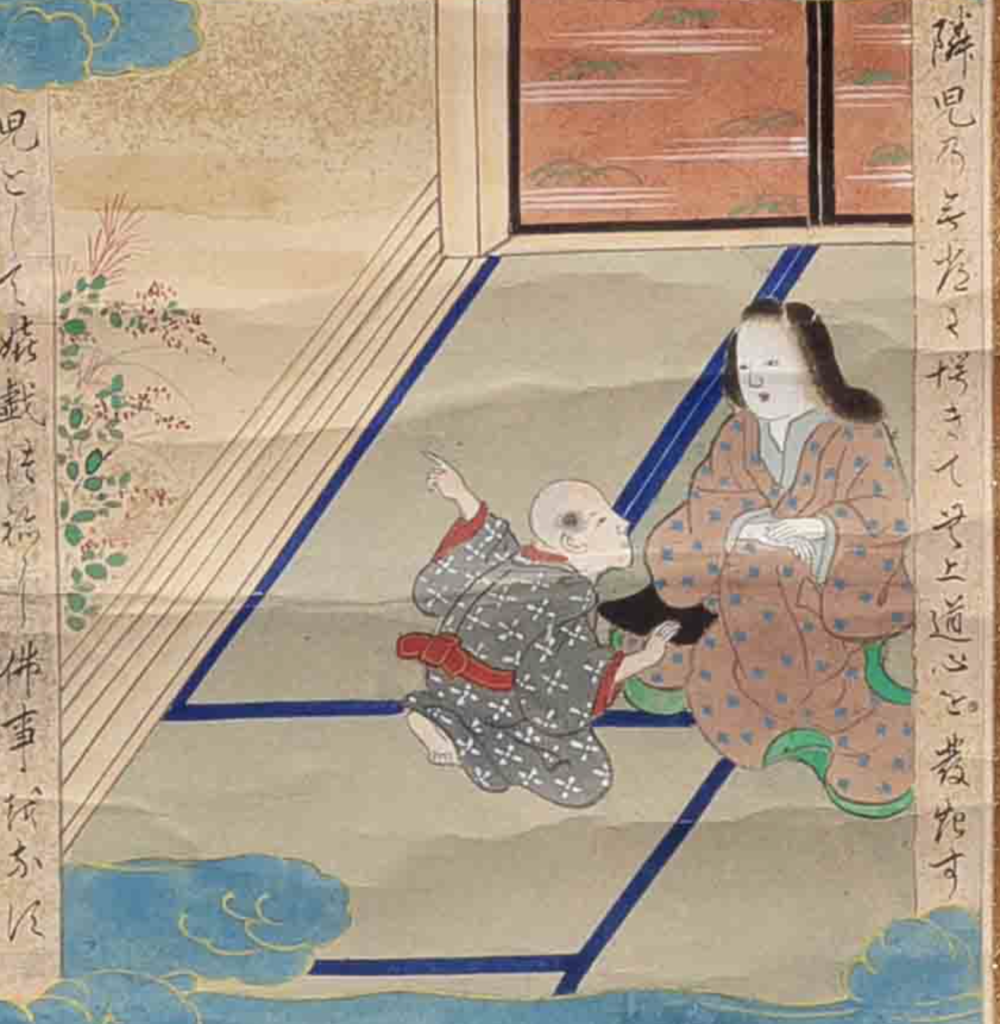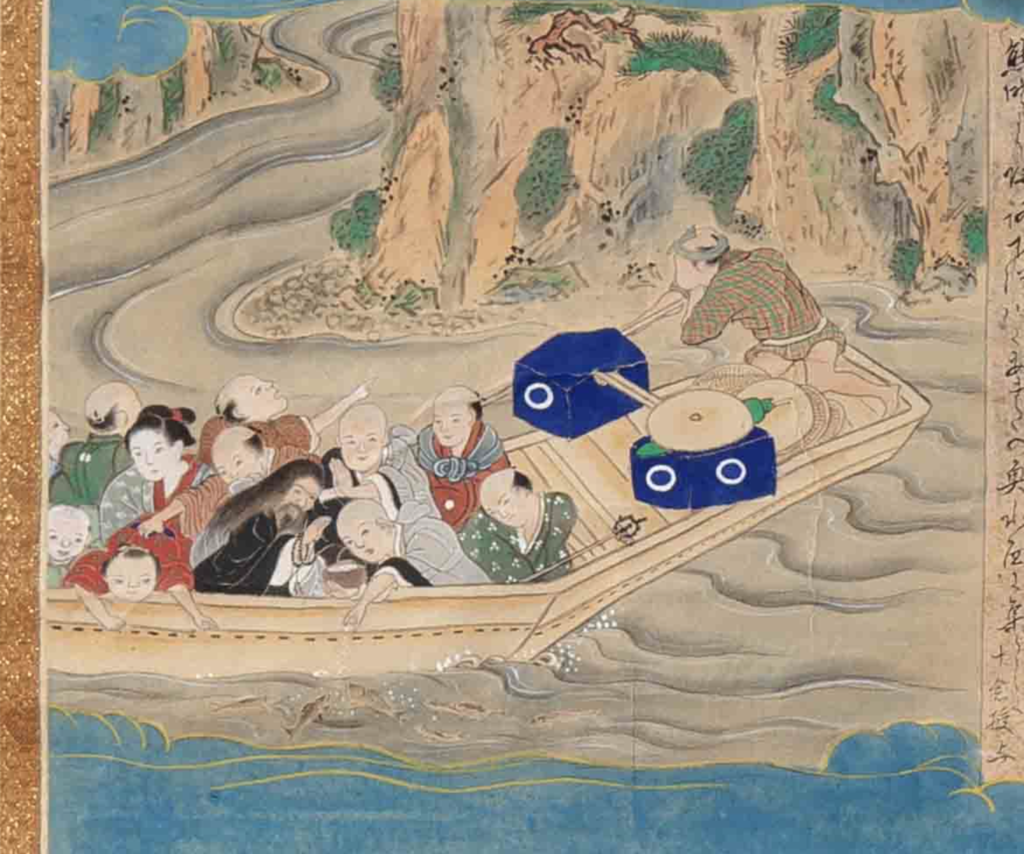Ramon Carrillo Martinez
Overview
This exhibition examines five images that showcase correlation between the Buddhist universal truth of impermanence—that “Everything changes”–represented in the works of art. The initial inspiration of the exhibition was examining the clay statues in The Five- storied Pagoda at Horyuji. The clay statues interestingly depict Buddha painted in gold paint on his deathbed as he puts a peaceful facial expression. Whereas some of his disciple’s weep and others interestingly have an accepting facial expression. This immediately raises the question of how the thought of can losing someone you cherish can be accepted as it was depicted in the clay statues in The Five- storied Pagoda. When conducting research about Buddhism.
This religion was first introduced to japan during the 6th century by China and Korea. Although Buddhism was welcomed by emperors of japan it was not intentionally followed by the common people due to the complex principles and practices. Unlike other religions such as Christianity and Islam, Buddhism is not focused in praising a God. Rather in Buddhism the focus is on the individual and to end the suffering a person might endure. In Buddhism to end one’s suffering a person might practice meditation and the core teaching that Buddha insisted people to follow for enlightenment and the religious practice that many people followed was the three universal truths. Out of the three universal truth this exhibition focuses of the following principle of and everything depicted in the works of art.
Buddhism is enriched with philosophical teaching and beliefs. This exhibition was constructed in a way to visually see Buddhist practice in Japanese art and how “everything changes” is depicted differently throughout the board. By diving deep into the exhibition, the viewer not only comes out with knowledge about Buddhism, but people will learn about Japanese culture and how art revolving Buddhist principles differs from other works of art.
Many of the works of art range from the late 15th century to the 20th century. The works of art range from Buddhist statues, painting of a monk’s journey and season change, a scroll of women’s beauty change, and a print of a soldier and women. When selecting the images some of them are directly connected to Buddhism. Whereas some of the images are not labeled as traditional Buddhist art they still have the Buddhist philosophy of “Everything changes” rooted in them. All the works of art uniquely demonstrates change is inevitable and although this is rooted in Buddhist religion this exhibition is designed for the veers to reflect on the changes that might have happened in their life. This exhibition not only shows how we are culturally and spiritually different, but it brings the audience together with the same understanding that change is inevitable.

Title: Birds and flowers of the four seasons
Artist: Sesshu Toyo
Medium: Ink and color on paper
Dimensions: H x W: 178.3 x 375.7cm
Type: Screen (six-panel)
Culture: Japan
Date: Late 15th– Early 16th Century
Description:
When people think of change, they often overlook their surrounding area and forget the environment surrounding them consistently changes depending on the region of the world they are living in. Buddhism not only focuses on the individual, but it also looks at the surrounding area and how the environment as well goes through an inevitable change. The six-panel painting “Birds and Flowers of the Four Seasons” by the artist Sesshu Toyo without a doubt used his Buddhist practices as a source of inspiration to visually emphasize how “Everything Changes”. The painting toward the left has a clearer sky like how someone would walk outside on a spring or summer day. The mountain is more visible as it has more coloring to it because of grass growing out of it. The trees are full of life as they begin to bloom and as the environment transitions to summer the painting showcases birds that can survive during the summer such as the red crowned crane. Not only is the environment changing but the bird as well must make the long journey of migration to begin breeding to expand the species. When shifting to the right the environment makes a dramatic change of foggy and snowy clouds demonstrating that winter is coming. The trees look lifeless with either no leaves or brown ones due to the season change. Because of the lack of source of food there are birds on the right that are taking off to migrate somewhere warmer as the season changes. However, there are birds such as the mandarin duck and great egrets that can survive in cold weather emphasizing that the winter is approaching. The Painting of the four seasons not only beautifully demonstrates the process of season changing but because change is inevitable we as humans should be accepting of the change.

Title: Buddha on his death bed
Creator: Unknown
Date: 711
Period: Nara period
Culture: Japan
Medium: Clay over wood and metal
Dimensions: Average of 40 to 60 centimeter tall
Repository: The Five- storied Pagoda at Horyuji
Credit line: unknown
ID number: unknown
Description:
The death of someone that you cherish can be one of the heart-breaking experiences that anyone can go through in their lifetime. However, the clay statue showcasing the Buddha on his deathbed in the Five-Storied Pagoda at Horyuji demonstrates how this dramatic change in life is accepted differently in Buddhism. For instance, Buddha himself is gently and peacefully lying down on his side as looks out to the viewers with a content facial expression. Although the Buddha is accepting of his own death, some of the followers are not accepting of this change. Many of them are devastated with sadness, when looking at the faces of the followers you can almost hear their cries for the death of Buddha. Whereas for the two figures in the middle wearing the crowns, they are known as bodhisattvas who follow Buddha and are completely enlightened. Due to these figures in the middle being enlightened they have a more accepting and calm facial expression of the Buddha’s death having a complete understanding of everything that changes in life.




Title: The Monk’s Path
Creator: Unknown
Period: Edo period
Date: 1758-1818
Culture: Japan
Medium: four ink and color
Dimensions: unknown
Repository: unknown
Description:
Many of the people that would follow these practices and distanced themselves from things such as desire to achieve enlightenment were monks. However, for a monk to achieve enlightenment they must go through a journey of learning the teachings of Buddhism and meditation. This journey of an ordinary person transitioning to monk is shown in the painting of 24 episodes. In the beginning of the pictorial narrative, the monk is born through his parents asking for a child at a temple. As we further read through the paintings the main character of the story tradition to a monk as he cut his hair and begins his journey as a monk. Through this journey his meets new people and explores new aspects of life. As we come to an end of the monks journey we can see that he is now an old man sailing off to the end of his life cycle.

Title: painting; hanging scroll; storage box
Artist: Kitagawa Utamaro
Dimension: H 124cm x W 73cm
Type: Hanging Scroll
Origin: Japan
Date: 19th century
Repository: unknown
Like a flower, beauty has a cycle of a beginning to an end. For some people this can be a devastating realization that a person’s youthfulness is slipping right through their finger’s tips. The realization of aging and losing one’s “beauty” has a bittersweet moment of growth that one develops as they age. For instance, in the painting the Japanese woman prepares herself for her daily routines of brushing her teeth and washing her face with a cloth. As she prepares herself for the day, on her right-hand side a beautiful mourning flower opens in the morning and will close later in the evening. As the woman admirably gazes at the mourning flower, this can be a realization that as the beautiful mourning blooms as she wakes up and closes in the evening it emphasizes the point that beauty does not last forever. The old social norms that a woman’s value lies in her beauty and youth rather than people embracing the change in a women’s beauty.

Title: Soldier and woman
Creator: Unknown
Period: Meiji to Taisho
Date: Early 20th Century
Culture: Japan
Dimensions: : 30.7 cm x 22 cm
Repository: Robert O. Muller Collection
Credit line: Unknown
ID number: Unknown
Description: There is no doubt that saying goodbye to a loved one can be the most difficult thing a person can do, especially if it is the final one. The woodblock print of the Soldier and Women highlight this struggle but at same time both individuals come to terms of acceptance while hinting that this print may have some ties to Buddhist belief. The woodblock print showcases a man and women. The man is dressed in a medium tone brown military attire because during this time many people were sent off to fight in a war. The woman is dressed in traditional Japanese clothing and both individuals have their heads tilted down looking in two different directions. Both individuals have their eyes closed as they gently lean towards each other as they cherish potentially the last moments that they have with each other. The color palette of soft color tones helps contribute to the sadness to the woodblock print. Interestingly, for most people the thought of saying goodbye to a loved one can bring nothing but sadness. However, when visually looking at the man and women not a single tear or any signs of sadness is depicted in this work art. This raises questions to think that perhaps both these individuals have some sort of knowledge or practice Buddhism of the three universal truths. Out of the three universal truths, “Everything Changes” is best represented in this print. As both individuals look down trapped in their own thoughts the idea of accepting that everything comes to an end lingers through their mind.
Bibliography
Images
“Birds and Flowers of the Four Seasons: Autumn and Winter.” Freer Gallery of Art & Arthur M. Sackler Gallery. April 30, 2021. https://asia.si.edu/object/F1953.95/.
“Five-storied Pagoda (Goju-no-To): Horyuji Temple.” Japanese. http://www.horyuji.or.jp/en/garan/gojyunoto/.
“Horyu-ji Temple, Nara.” Horyuji Temple – Nara, Japan. http://www.taleofgenji.org/horyuji.html.
Larson, Kay. “A Hidden Trove of Japanese Buddhist Art Revealed in New Jersey.” Tricycle. July 28, 2020. https://tricycle.org/trikedaily/newark-museum/.
“Soldier and Woman, Russo-Japanese War Print? (previously Mistakenly Numbered AND043A).” Freer Gallery of Art & Arthur M. Sackler Gallery. October 13, 2021. https://asia.si.edu/object/S2003.8.3734/.
“Painting; Hanging Scroll; Storage Box: British Museum.” The British Museum. https://www.britishmuseum.org/collection/object/A_1965-0724-0-4
Texts
Bechert, H., & Gombrich, Richard F. (Richard Francis). (1984). The World of Buddhism : Buddhist monks and nuns in society and culture. Facts on File.
THE BUDDHIST CORE VALUES AND PERSPECTIVES FOR PROTECTION CHALLENGES: FAITH AND PROTECTION
Cartwright, M. (2019). Life in a Japanese Buddhist Monastery – World History Encyclopedia
Graham, P. J. (2007). Faith and power in Japanese Buddhist art, 1600-2005. University of Hawaii Press.
Robinson, R. H., Johnson, W. L., Wawrytko, Sandra A. (Sandra Ann), & Ṭhānissaro. (1996). The Buddhist Religion : a historical introduction (4th ed.). Wadsworth Pub. Co.
Rosenfield, J. M. (2015). Preserving the dharma : Hōzan Tankai and Japanese Buddhist art of the early modern era. P.Y. and Kinmay W. Tang Center for East Asian Art, Department of Art and Archaeology Princeton University.
Acknowledgment
Thank you to Charles Silver at National Museum of Asian Art for providing the image of the solider and women.
To even the most casual observer, everything from silk calligraphy and pottery to manga drawings and woodblock prints will spring to mind. Part of that delightfulness arose within the context of their traditions, with its ceremonies and dress.